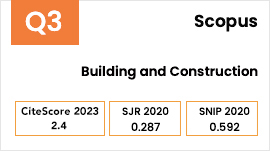2Department of Geology, Kasdi Merbah University, Faculty of Hydrocarbons, Renewable Energies and Earth and Universe Sciences, Ouargla, 30000, Algeria
3Department of Physics, University Abdelhamid Ibn Badis of Mostaganem, Faculty of Exact Sciences and Computer Science, Mostaganem, 27000, Algeria
4Theoretical and Applied Fluid Mechanics Laboratory, Department of Energetic and Fluid Mechanics, University of Science and Technology Houari Boumediene (USTHB), Algiers, 16111, Algeria
5LEVRES Laboratory, University of El Oued, Faculty of Technology, El Oued, 39000, Algeria
Abstract
Solar chimneys are used to ventilate residential buildings, helping reduce infections caused by the recent COVID-19 pandemic. An experimental investigation was conducted to evaluate the efficiency of rooftop solar chimneys by assessing the thermal performance of two small rooms constructed from the two most commonly used building materials in the region: local stone and hollow brick. The study examined the effects of building materials, chimney inclination (angles of 30°, 45°, and 60°), and air gaps (0.15 m and 0.25 m) on the chimney’s performance under real climatic conditions at the University of Ouargla, Algeria, known for its dry and hot climate, from May 8 to 13, 2021. The results showed that installation factors significantly affect the performance of solar chimneys. The inclination angle had the most significant impact, potentially enhancing performance by up to 20%. Additionally, selecting suitable building materials, such as local stone, for specific geographical areas can improve performance by at least 15% during peak times. The air gap, as a configuration factor, contributes to a 14% improvement in performance. The analysis revealed that the highest indoor air velocity in the living area can be achieved using a solar chimney with specific dimensions of 1 m x 0.65 m, an air gap of 0.25 m, and an inclination angle of 45°. At average solar radiation levels of 550, 800, and 950 W/m2, the solar chimney can achieve air change rates of 5, 6.5, and 7.8 air changes per hour (ACH), respectively.























